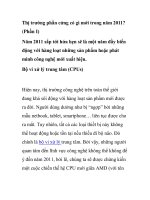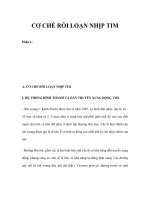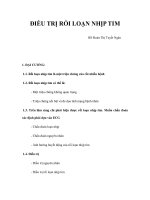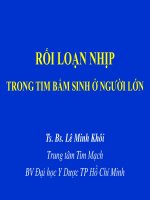Rối loạn nhịp tim có gì mới trong năm 2015 2016
Bạn đang xem bản rút gọn của tài liệu. Xem và tải ngay bản đầy đủ của tài liệu tại đây (2.71 MB, 36 trang )
Cardiac Arrhythmias in the year
Review: 2015-2016
Dr. Reginald Liew
MA, MB BS (Hons), PhD, FRCP, FACC, FESC, FAsCC
Director/ Senior Consultant Cardiologist
The Harley Street Heart and Cancer Centre
Mount Elizabeth Novena Specialist Centre, Singapore
Outline of presentation
•
•
•
•
AF ablation strategies
AF ablation techniques
Other arrhythmias
ICDs and advances in pacing
Outline of presentation
•
•
•
•
AF ablation strategies
AF ablation techniques
Other arrhythmias
ICDs and advances in pacing
Verma et al. for the STAR AF II Investigators
N Engl J Med 2015; 372:1812-182
STUDY QUESTION• What is the optimal strategy for ablation of persistent AF? Does the addition of
CFAE and linear ablation add any benefit to PVI alone?
METHODS
• 589 patients with persistent AF randomly assigned in a 1:4:4 ratio to ablation
with PVI alone (67 patients), PVI plus ablation of CFAEs (263 patients), or PVI
plus additional linear ablation across the left atrial roof and mitral valve isthmus
(259 patients).
• The duration of follow-up was 18 months.
• The primary end point was freedom from any documented recurrence of AF
lasting longer than 30 seconds after a single ablation procedure.
STAR II study results- Freedom from AF
RESULTS
• Procedure time was significantly shorter for PVI alone than for the other two procedures
(P<0.001).
• After 18 months, 59% of patients assigned to PVI alone were free from AF vs 49% of
patients assigned to PVI plus CFAEs and 46% of patients assigned to PVI plus linear
ablation (P=0.15).
• There were also no significant differences among the three groups for the secondary end
points, including freedom from AF after two ablation procedures
Volger et al. JACC 2015, Vol. 66, No. 24
• Prospective randomized study comparing PVI alone
vs PVI + CFAE + linear lesions in patients with
persistent AF.
• Methods
– 205 patients (151 men; 61.7 ± 10.2 years of age)
underwent de novo ablation for persistent AF.
– Subsequently, patients were prospectively
randomized to either PVI alone (n = 78) or full
defrag (n = 75), with 52 patients not randomized
due to AF termination with the original PVI.
– The primary endpoint was recurrence of any atrial
arrhythmia after a blanking period of 3 months.
CHASE AF study- results
• Results No difference in arrhythmia-free survival between the two methods (p =
0.468). Procedure duration, fluoroscopy time, and radiofrequency duration were
significantly longer in the full-defrag group (all p < 0.001).
• Conclusions A stepwise approach aimed at AF termination does not seem to
provide additional benefit over PVI alone in patients with persistent AF, but it is
associated with significantly longer procedural and fluoroscopic duration as well as
RF application time.
Di Base et al, Circulation 2016; 133: 1637-1644
• Open-label, randomized multi-centre study to
determine whether catheter ablation (CA) was
superior to amiodarone (AMIO) for the treatment of
persistent AF in patients with heart failure
• Study group- NYHA II-III HF, LVEF<40% with dual
chamber ICD or CRT-D device
• 203 pts randomized (N=102 in CA group and 101 in
AMIO group)
• Pts followed up for minimum of 24 months
• Primary end point- recurrence of AF
Main results- AATAC study
• Success rate of CA after a single procedure 29-61%
• AMIO therapy found to be significantly more likely to fail
• CA group showed a significant reduction in:
– unplanned hospital admissions (RRR 0.55; CI 0.39-0.76)
– Mortality (8% in CA group vs 18% in AMIO group; P=0.037)
Pathak et al. JACC 2015, Vol. 66, No. 9
• Objectives To evaluate the role of cardiorespiratory fitness and the
incremental benefit of cardiorespiratory fitness improvement on rhythm
control in obese individuals with AF.
• Methods
– 1,415 consecutive patients with AF, 825 had a BMI ≥27 kg/m2 and
were offered risk factor management and participation in a tailored
exercise program.
– After exclusions, 308 patients were included in the analysis.
– Patients underwent exercise stress testing to determine peak
metabolic equivalents (METs). To determine a dose response,
cardiorespiratory fitness was categorized as: low (<85%), adequate
(86% to 100%), and high (>100%).
– Impact of cardiorespiratory fitness gain was ascertained by the
objective gain in fitness at final follow-up (≥2 METs vs. <2 METs). AF
rhythm control was determined using 7-day Holter monitoring and AF
severity scale questionnaire.
CARDIOFIT study results
% improvement from
baseline CRF
• Results Improved arrhythmia free survival in patients with high cardiorespiratory
fitness compared to adequate or low cardiorespiratory fitness (p < 0.001 for both).
• Less AF burden and symptom severity in the group with cardiorespiratory fitness
gain ≥2 METs (p < 0.001 for all).
• Conclusions Cardiorespiratory fitness predicts arrhythmia recurrence in obese
individuals with symptomatic AF. Improvement in cardiorespiratory fitness augments
the beneficial effects of weight loss
CARDIOFIT study
Outline of presentation
•
•
•
•
AF ablation strategies
AF ablation techniques
Other arrhythmias
ICDs and advances in pacing
TOCCASTAR study
Reddy et al. Circulation 2015; 132: 907-915
• Prospective, multi-centre RCT.
• 300 pts with drug-refractory PAF
randomized to RF ablation with a novel
contact force (CF) sensing catheter or non-CF
catheter (control)
• Primary effectiveness endpoint- acute PV
isolation and freedom from recurrent AF and
off AADs at 12 months
• Primary safety endpoint- device-related
SAEs
TOCCASTAR study results
•
•
•
•
All PVs successfully isolated in both groups
67.8% in CA group and 69.4% in control group (non-inferior)
Primary effectiveness similar in study and control groups
Within study group, greater success when optimal contact force
(>80%) was achieved
TOCCASTAR study- effect of contact force
• Analysis of optimal vs nonoptimal contact force (CF) by operator showed
improved treatment success in cases where operators achieved >80% of
optimal CF
• No significant difference in SAE between optimal and nonoptimal CF cases
Cryoballoon ablation of PV
Freeze AF study
Luik et al, Circulation 2015; 132: 1311-1319
• First RCT comparing RF ablation with cryoballoon for
paroxysmal AF ablation
• 315 pts with PAF randomly assigned to receive RF
ablation (N=159) vs cryoballoon (N=156).
• Primary end-point- freedom from atrial arrhythmia with
absence of any persistent complication
Freeze AF study- results
Main result:
• After 12 months, 70.7% free from AF in RF group and 73.6% in CB group
(31 redo procedures in each group)
• More complications in CB group (12.2% vs 5.0%), mainly due to phrenic
nerve palsies
Conclusions:
• First large randomized trial demonstrating that cryoballoon was non inferior to
RF ablation
• More complications in cryo group, but resolved within 12 months
• Technically easier and less training required for cryo technique
FIRE AND ICE STUDY
Kuck KH et al, NEJM 2016; 374;23
• Multicentre RCT investigating noninferiority of cryoballoon vs RF
ablation for symptomatic, drug
refractory PAF
• 762 pts randomized; followed up for
1.5 years
• Primary endpoints- time to AF
recurrence, atrial flutter or atrial
tachy, use of AADs or repeat
procedure
Results- fire and ice study
- No sig difference in efficacy or
safety between cryoballoon and RF
ablation
- No sig difference in complications:
•
•
Groin complications (16 in RF and 7 in
cryo group)
10 phrenic nerve injuries cryo group
(2.7%)- most resolved after 3 months
Outline of presentation
•
•
•
•
AF ablation strategies
AF ablation techniques
Other arrhythmias
ICDs and advances in pacing
Sapp et al. NEJM July 2016, vol 372, no.2
Study question- should patients with ischaemic CM,
ICDs and recurrent VT undergo catheter abaltion or
escalation of AADs?
• Multicentre RCT in 259 pts with ischaemic
cardiomyopathy, ICD and recurrent VT despite being on
AADs
• Randomised to VT ablation (132 pts) or escalation of AAD
(amiodarone or mexiletine if already on 300mg amiodarone
per day; 127 pts)
• Primary end-point composite of death, VT storm, or
appropriate ICD shock
Lower rate of primary endpoint in pts
undergoing VT ablation
Sapp JL et al. N Engl J Med 2016;375:111-121
Outline of presentation
•
•
•
•
AF ablation strategies
AF ablation techniques
Other arrhythmias
ICDs and advances in pacing









